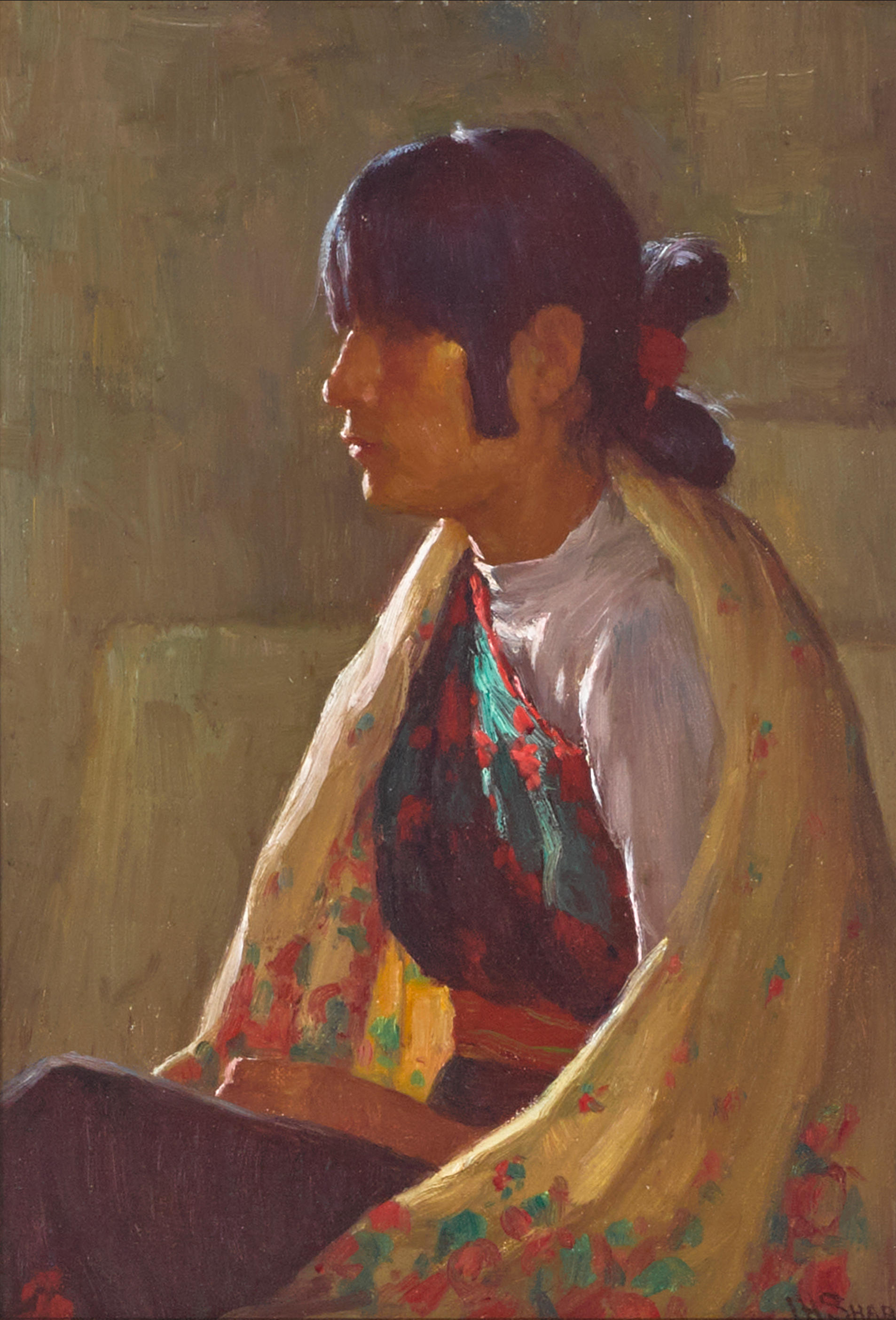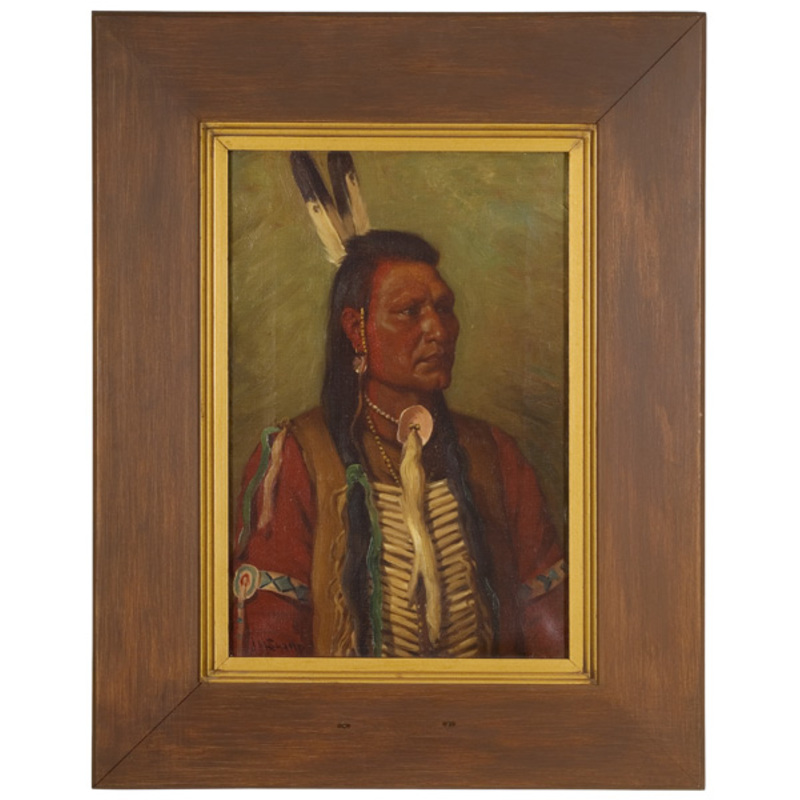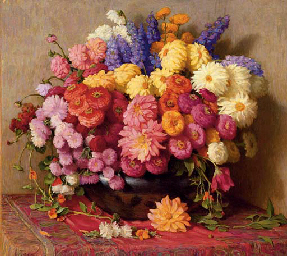Joseph Henry Sharp (1859-1953)Bawling Deer (Frank Martinez Păh Wēlah) signed 'J.H. SHARP' (lower left) and titled (on the reverse) oil on board 13 1/2 x 9 3/4 in. framed 19 3/4 x 16 in.FootnotesProvenance Gerald Peters Gallery, Santa Fe, New Mexico. Private collection, Utah, from the above. Exhibited Springville, Utah, Springville Museum of Art, The Taos Masters & Western Artists Exhibit, September 19 - October 26, 2004. Salt Lake City, Utah, Utah Museum of Fine Arts, Bierstadt to Warhol: American Indians in the West, February 15 – August 11, 2013. Joseph Henry Sharp's skill and interest in presenting interior figural subjects in firelight and deep shadow is evident in the present painting, Bawling Deer. The painting is executed with mature techniques honed during Sharp's time in Taos, and features his mastered ability to capture the likeness of one of his favorite Native American subjects, Bawling Deer (Păh Wēlah) also known as Frank Martinez Sharp is recognized today as one of American art history's most beloved painters of Native Americans and the American West with an oeuvre spanning more than six decades. He is also widely considered the spiritual father of the Taos Art Colony and through his friendships with Ernest Blumenschein, Bert Geer Phillips Eanger Irving Couse among others, he was a founding member of the Taos Society of Artists. Sharp was born in Bridgeport, Ohio in 1859 to Irish immigrant parents, and from an early age, was fascinated with the life of Native Americans. Due to a childhood swimming accident, Sharp was completely deaf by the time he was an adult. His hearing impairment as a teenager led him to leave public school and he instead studied art at the McMicken School and the Cincinnati Academy of Art in Cincinnati. In Cincinnati, his studio was in the same building as the studio of artist Henry Farny, and the two became friends. Farny shared books that illustrated and described the life of Pueblo Indians with the younger artist, and the two men had lively discussions about Native Americans culture. Sharp first went to Taos in 1893, and his sketches from the trip were published in Harper's Weekly. In the subsequent years, he made regular summer trips to western states including Arizona, California, Wyoming and Montana in order to sketch and paint Native American peoples and the landscape. By 1912, Sharp was a permanent resident of Taos and amassed an extensive personal collection of Native American artifacts and costume that he frequently used in his paintings. Sharp felt strongly that the artifacts he collected be preserved and that what and how he depicted his Native American subjects be as authentic as possible. He believed this to be the best way to fully understand and appreciate what he observed in Native American culture, making him as much of an amateur anthropologist as he was a painter. In Bawling Deer, the interior lighting is produced by firelight outside the picture plane. Sharp's carefully staged indoor studio compositions are intensified by the golden glow of the fire and the deep shadows that the directed light creates. "With the element of light from fire, Sharp tapped into something primal, a dialogue between light and darkness that reached back to early humans who created and viewed cave painting by firelight...In deep silence, seated models, with faces glowing orange before a fire, sometimes hold objects – from pipes to shields to bows to warbonnets – in nostalgic reveries of past days and contemplation of what is to come." 1 In Bawling Deer, the figure stares intently toward the fire holding a pipe in his right hand. A still life vignette of a small long-necked gourd and an American flag bead-decorated leather glove are positioned on the bench next to the sitter, the objects perhaps signaling ideas about both the ancient and modern life of a Pueblo man. Bawling Deer's traditional breechcloth and fringed leggings, and his right braid covered by a green buckskin wrap, add rich detai
Joseph Henry Sharp (1859-1953)Bawling Deer (Frank Martinez Păh Wēlah) signed 'J.H. SHARP' (lower left) and titled (on the reverse) oil on board 13 1/2 x 9 3/4 in. framed 19 3/4 x 16 in.FootnotesProvenance Gerald Peters Gallery, Santa Fe, New Mexico. Private collection, Utah, from the above. Exhibited Springville, Utah, Springville Museum of Art, The Taos Masters & Western Artists Exhibit, September 19 - October 26, 2004. Salt Lake City, Utah, Utah Museum of Fine Arts, Bierstadt to Warhol: American Indians in the West, February 15 – August 11, 2013. Joseph Henry Sharp's skill and interest in presenting interior figural subjects in firelight and deep shadow is evident in the present painting, Bawling Deer. The painting is executed with mature techniques honed during Sharp's time in Taos, and features his mastered ability to capture the likeness of one of his favorite Native American subjects, Bawling Deer (Păh Wēlah) also known as Frank Martinez Sharp is recognized today as one of American art history's most beloved painters of Native Americans and the American West with an oeuvre spanning more than six decades. He is also widely considered the spiritual father of the Taos Art Colony and through his friendships with Ernest Blumenschein, Bert Geer Phillips Eanger Irving Couse among others, he was a founding member of the Taos Society of Artists. Sharp was born in Bridgeport, Ohio in 1859 to Irish immigrant parents, and from an early age, was fascinated with the life of Native Americans. Due to a childhood swimming accident, Sharp was completely deaf by the time he was an adult. His hearing impairment as a teenager led him to leave public school and he instead studied art at the McMicken School and the Cincinnati Academy of Art in Cincinnati. In Cincinnati, his studio was in the same building as the studio of artist Henry Farny, and the two became friends. Farny shared books that illustrated and described the life of Pueblo Indians with the younger artist, and the two men had lively discussions about Native Americans culture. Sharp first went to Taos in 1893, and his sketches from the trip were published in Harper's Weekly. In the subsequent years, he made regular summer trips to western states including Arizona, California, Wyoming and Montana in order to sketch and paint Native American peoples and the landscape. By 1912, Sharp was a permanent resident of Taos and amassed an extensive personal collection of Native American artifacts and costume that he frequently used in his paintings. Sharp felt strongly that the artifacts he collected be preserved and that what and how he depicted his Native American subjects be as authentic as possible. He believed this to be the best way to fully understand and appreciate what he observed in Native American culture, making him as much of an amateur anthropologist as he was a painter. In Bawling Deer, the interior lighting is produced by firelight outside the picture plane. Sharp's carefully staged indoor studio compositions are intensified by the golden glow of the fire and the deep shadows that the directed light creates. "With the element of light from fire, Sharp tapped into something primal, a dialogue between light and darkness that reached back to early humans who created and viewed cave painting by firelight...In deep silence, seated models, with faces glowing orange before a fire, sometimes hold objects – from pipes to shields to bows to warbonnets – in nostalgic reveries of past days and contemplation of what is to come." 1 In Bawling Deer, the figure stares intently toward the fire holding a pipe in his right hand. A still life vignette of a small long-necked gourd and an American flag bead-decorated leather glove are positioned on the bench next to the sitter, the objects perhaps signaling ideas about both the ancient and modern life of a Pueblo man. Bawling Deer's traditional breechcloth and fringed leggings, and his right braid covered by a green buckskin wrap, add rich detai









.jpg)





Try LotSearch and its premium features for 7 days - without any costs!
Be notified automatically about new items in upcoming auctions.
Create an alert